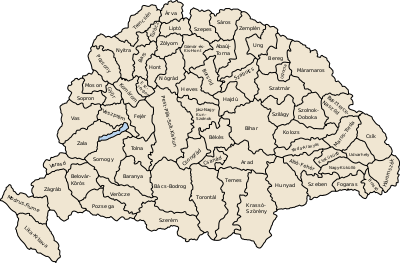Abaúj-Torna County
Abaúj-Torna (Slovak: Abov-Turňa, German: Abaujwar-Tornau, Latin: comitatus Abaujvar-Tornensis) was an administrative county (comitatus) of the Kingdom of Hungary. Its capital was Kassa (present-day Košice). Its territory is now divided between Hungary and Slovakia.
| Abaúj-Torna County | |
|---|---|
| County of the Kingdom of Hungary | |
| 1881–1945 | |
.svg.png) Coat of arms
| |
 | |
| Capital | Kassa; Szikszó (1920-1938) |
| Area | |
• 1910 | 3,223 km2 (1,244 sq mi) |
• 1930 | 1,672 km2 (646 sq mi) |
| Population | |
• 1910 | 202288 |
• 1930 | 91428 |
| History | |
• Established | 1881 |
• Treaty of Trianon | 4 June 1920 |
• First Vienna Award | 2 November 1938 |
• Renamed to Abaúj County | 1945 |
| Today part of | (1,672 km2) (1,551 km2) |
| Košice is the current name of the capital. | |
Geography
Around 1910, Abaúj-Torna county shared borders with the counties Gömör-Kishont, Szepes, Sáros, Zemplén, and Borsod. The rivers Hernád and Bódva flowed through the county. Its area was 3317 km² around 1910.
History
The county Abaúj-Torna was a combination of the counties Abaúj and Torna, officially joined in 1881.
In the aftermath of World War I, the northern part of Abaúj-Torna county became part of newly formed Czechoslovakia (as Abovskoturnianska župa), as recognized by the concerned states in the 1920 Treaty of Trianon. It continued to exist as an administrative unit until 1922. The southern half stayed in Hungary as the county Abaúj-Torna, with capital Szikszó.
Following the provisions of the First Vienna Award, most of the Czechoslovak part was returned to Hungary in November 1938. It was added to the county Abaúj-Torna, with capital Kassa (present-day Košice). After World War II, the Trianon border was restored, the county was renamed to Abaúj County again. In 1950, it merged with the county of Borsod-Gömör and the Hungarian part of Zemplén to form the present Borsod-Abaúj-Zemplén county. Since 1993, when Czechoslovakia was split, the northern part of the county's former territory is part of Slovakia's Košice Region.
Demographics

In 1900, the county had a population of 196,462 people and was composed of the following linguistic communities:[1]
Total:
- Hungarian: 140,050 (71.3%)
- Slovak: 45,072 (22.9%)
- German: 8,734 (4.5%)
- Ruthenian: 519 (0.3%)
- Croatian: 74 (0.0%)
- Romanian: 60 (0.0%)
- Serbian: 13 (0.0%)
- Other or unknown: 1,940 (1.0%)
According to the census of 1900, the county was composed of the following religious communities:[2]
Total:
- Roman Catholic: 113,447 (57.7%)
- Calvinist: 41,562 (21.2%)
- Greek Catholic: 20,142 (10.3%)
- Jewish: 14,069 (7.2%)
- Lutheran: 7,101 (3.6%)
- Greek Orthodox: 106 (0.0%)
- Unitarian: 18 (0.0%)
- Other or unknown: 17 (0.0%)

In 1910, the county had a population of 202,288 people and was composed of the following linguistic communities:[3]
Total:
- Hungarian: 156,668 (77.5%)
- Slovak: 36,067 (17.8%)
- German: 6,520 (3.2%)
- Ruthenian: 378 (0.2%)
- Romanian: 127 (0.0%)
- Croatian: 63 (0.0%)
- Serbian: 21 (0.0%)
- Other or unknown: 2,444 (1.2%)
According to the census of 1910, the county was composed of the following religious communities:[4]
Total:
- Roman Catholic: 118,179 (58.4%)
- Calvinist: 42,728 (21.1%)
- Greek Catholic: 20,089 (9.9%)
- Jewish: 14,251 (7.1%)
- Lutheran: 6,832 (3.4%)
- Greek Orthodox: 161 (0.0%)
- Unitarian: 24 (0.0%)
- Other or unknown: 24 (0.0%)
In 1941: 203,438 Hungarians, 18,879 Slovaks, 2581 Bunjevacs, 904 Germans, 623 Roma, 256 Ruthenians, 72 Romanians, 3 Croatians, 105 other; 140,377 Roman Catholics, 45,384 Protestants, 22,476 Greek Catholics, 14,764 Jewish, 4773 Evangelicals, 339 Greek Orthodox, 116 Baptists and 55 Unitarians.
Subdivisions

In the early 20th century, the subdivisions of Abaúj-Torna were:
| Districts (járás) | |
|---|---|
| District | Capital |
| Cserehát | Szepsi, (Slovak: Moldava nad Bodvou) |
| Füzér | Hernádzsadány, (Slovak: Ždaňa) |
| Gönc | Abaújszántó |
| Kassa | Kassa, (Slovak: Košice) |
| Szikszó | Szikszó |
| Torna | Torna, (Slovak: Turňa nad Bodvou) |
| Urban counties (törvényhatósági jogú város) | |
| Kassa, (Slovak: Košice) | |
The towns Füzér, Szikszó, Gönc and Abaújszántó are now in Hungary.
References
- "KlimoTheca :: Könyvtár". Kt.lib.pte.hu. Retrieved 2012-12-06.
- "KlimoTheca :: Könyvtár". Kt.lib.pte.hu. Retrieved 2012-12-06.
- "KlimoTheca :: Könyvtár". Kt.lib.pte.hu. Retrieved 2012-06-24.
- "KlimoTheca :: Könyvtár". Kt.lib.pte.hu. Retrieved 2012-06-24.
